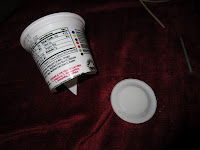In the last post we had set up the spokes or spines for the basket and were ready to start weaving. I have the kids take a stretch of reed that is about two wing spans long for the weaving part. Make sure you keep your reed soaking in a bucket of water either at each table for the kids to grab as they need or in a central location. You have to keep the reed wet or it cracks. I have them pull a tail and tape it down to the inside of the basket to start. Then we start going round and round over under over under.
ok now we have reached the end of our long reed and we need to tuck the end. Have the kids leave about an inch hanging out and then have them either run the basket under the sink facet or dip it into a bucket of water for a few seconds. Now we are going to fold and tuck the end of the reed.
If you can tuck the end UNDER you will get a cleaner looking basket. Now is where a lot of kids get mixed up. As they put the next reed into the basket make sure they keep following the Under over pattern and really pay attention.
If your kids are having problems with the tuck method then you can lay and overlap the ends of the reed. This leads to ends that tend to pop out more often though so I try to get them to bend and tuck.
Round and round we go. I encourage the kids to keep getting the baskets wet to make everything easier to work with and less likely to crack. At any point you can put pony beads on the spokes or spines to add a little unique touch. You can also dye the reed in Rit dye to get different colors.
Up and up we go till you have three or four inches left on the spokes/spines
Then set your basket upside down in water (I like to have a bucket of water on each table for the kids to use)
Time to finish the basket. Take each spoke and bend it over the spoke immediately to the left or right and tuck the end under the last row of weaving you did. We are making little rainbow arches.
When these are all dry you can clip the extra reed and then tada you have a fun little basket

















 figure out how many holes you are punching and divide it by two. Then cut that number of reeds about two feet long and one reed about one foot long. The longer reeds will basically be folded in half.
figure out how many holes you are punching and divide it by two. Then cut that number of reeds about two feet long and one reed about one foot long. The longer reeds will basically be folded in half. Thread the long reeds into the adjacent holes keeping the bottom of the cup still the bottom
Thread the long reeds into the adjacent holes keeping the bottom of the cup still the bottom This is what it looks like from the top
This is what it looks like from the top In this photo I have threaded all of the long reeds and then put the "short" read through our odd remaining hole leaving a inch or so hanging out of the bottom
In this photo I have threaded all of the long reeds and then put the "short" read through our odd remaining hole leaving a inch or so hanging out of the bottom and here we have a top view...the kids say it looks like and octopus at this point
and here we have a top view...the kids say it looks like and octopus at this point we are looking at the bottom again. I have my students use a piece of duct tape to take down the "tail " of our shorter reed and then write their name on the tape
we are looking at the bottom again. I have my students use a piece of duct tape to take down the "tail " of our shorter reed and then write their name on the tape